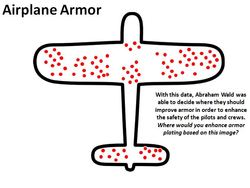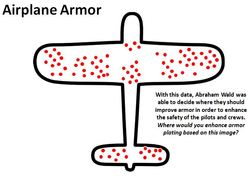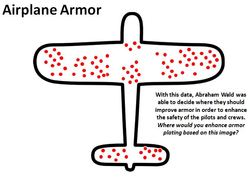


This is a great activity to get people thinking and talking. It works with all audiences, but it is particularly useful with technical audiences or those who are more data driven. There are many applications for this activity such as defying expectations, critical thinking or process improvement. This activity, along with many other closers, openers, revisiters and energizers appears in SCORE! for Webinar Training!
Objective: To encourage critical thought in a group in order to expose common misperceptions that we might have when solving problems
Webinar Length: At least 60 minutes
Instructor Skill Level: Novice/Intermediate
Participant Skill Level: Novice
Group Size: 5-30 participants
Activity Time: 5 minutes
Materials/Tools: Slides with image of an airplane with holes in it
Set-Up: Create the slide of the airplane image (or purchase the accompanying slide deck).
Trainer Process: Say, “During World War II, Abraham Wald, a Hungarian mathematician, was tasked with deciding where to enhance armor on bomber planes. An inventory was made of all returning planes and where they had been hit with enemy fire. With this data, Wald was able to decide where they should improve armor in order to enhance the safety of the pilots and crews. Where would you enhance armor plating based on this image?” Show the image of the planes and the enemy fire inventory. Say, “Text chat with a partner and decide where the new armor should be placed.” You may also choose to put learners in breakout rooms with a partner to facilitate verbal sharing in order to build relationships. Hear solutions and reasons. If no one comes up with the solution that Wald did, tell the group the solution listed below.
Solution: All of the planes that they took data from returned from their missions. While the holes are not desirable, they did not prevent the plane from returning home. The areas that are of most concern are the ones where there are no holes marked because these indicate areas of the plane that, when hit, prevent the airplane from returning back to the base.
Producer Process: If using breakout rooms:
1. Create breakout rooms and put the appropriate slide into them.
2. Split learners into appropriate rooms for the activity.
3. Set the timer.
4. Bring learners back to the main room when indicated.
Debrief: 1. What was most difficult as you solved this puzzle?
2. What did you find to be most logical for a solution?
3. What would have happened if the engineers had implemented your
recommendations?
4. If applicable, where did you go wrong in your analysis?
5. What was most important in solving this problem?
6. What are the implications for us?
7. What insights can you draw from this discussion?
Variations: Ask everyone to use their annotation tools to mark on the plane where they would put armor. After notating the position, have participants talk with a partner or in small groups to see what the ideal placement should be. You may then encourage participants to shift the placement of the armor based on their conversations.
by Scott Enebo
Don't miss out on updates and chances
to sharpen your skills with participant-centered learning.




3740 N Chestnut St #113 - Chaska, MN 55318-3053